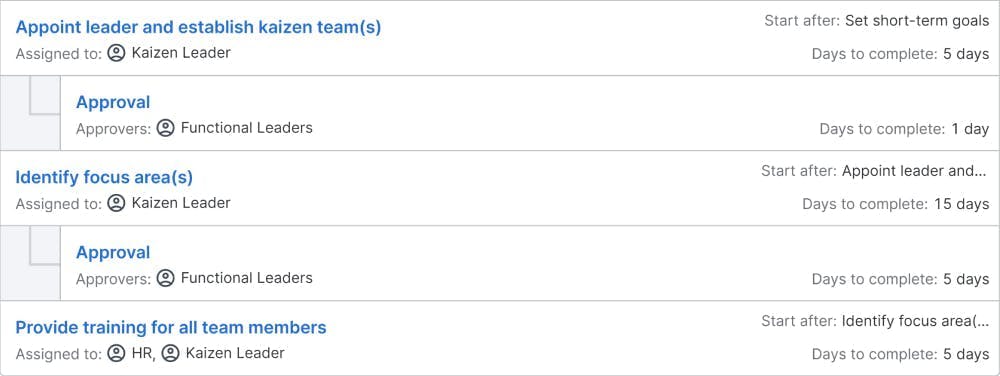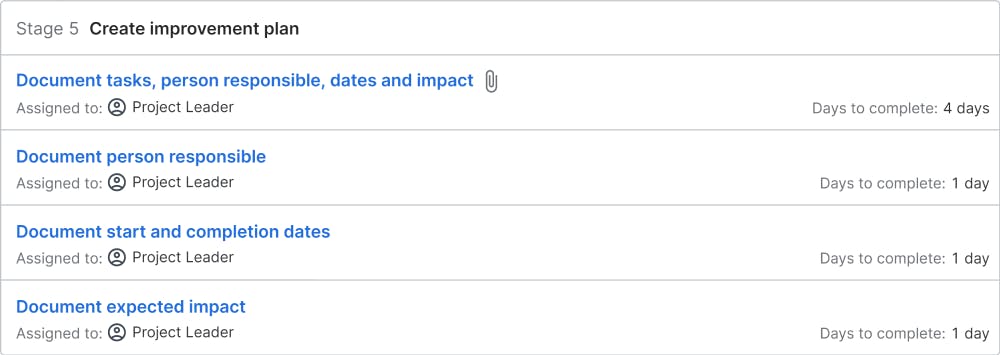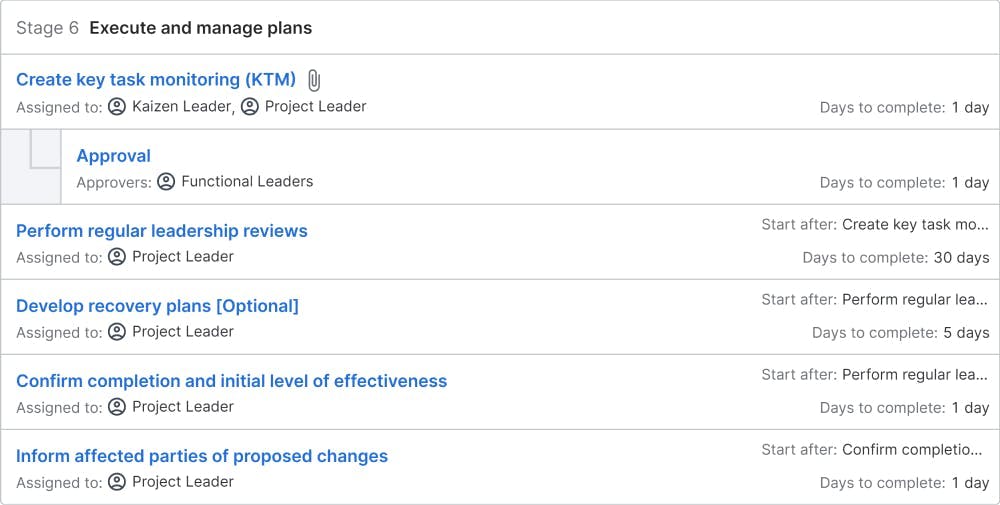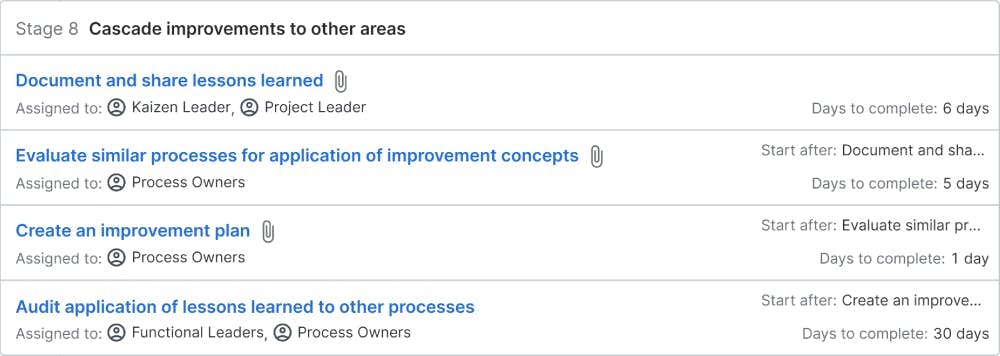Kaizen
The Kaizen Projects workflow captures the requirements to focus the organization on problem solving activities that address key priorities. Each functional group within an organization typically has objectives requiring improvement initiatives, and having projects identified and managed through standardized activities is an effective way to secure results. Incorporating a kaizen approach implies that the improvements will address the gap between the current state and the desired state through a series of incremental improvement steps. The action items required to make the improvement are typically discovered and documented through a team-based activity that focuses on establishing standardization, simplification, then specialization. Standardization is also critical to the efforts to manage the projects through to completion and to ensure that the development of new projects is an on-going activity.
STAGES

The following stages are identified in the blueprint:
Establish business objectives
This stage creates the link between what the business requires most and the establishment of projects that address the priorities. It also ensures that the top leadership’s commitment to the process is communicated so expectations are clear.
Each business likely has an established method of developing and communicating short and long term objectives, and this kaizen project's workflow should connect directly to that process. The critical outcome of this stage is the understanding of the improvement opportunity and identifying the focus area(s). Then a decision must be made whether to have a single kaizen leader to organize the efforts or to assign individuals within the functional areas in which the improvement is planned.
Understand the current condition
The intent of this stage is to truly understand the current state of the process through actual observation of the process working in real time. This is a fundamental kaizen concept. This phase of any kaizen project involves the team in formally documenting the process flow and collecting data on the process during their observation. This should drive the identification of weak points or opportunities for improvement. An often used tool to initiate the observation activity is value stream mapping. The mapping helps identify an area of improvement opportunity upon which the team then focuses their in-depth observation. The observation involves collecting data of the actual performance of the process during the observation period, not just securing historical data. The observations and data then form the basis for deciding on the project’s focus.
This stage, along with stages 3 through 5, is best executed as team-based activities. Typically, this is achieved through a workshop-like event for the project team, usually lasting for one week duration. By the conclusion of the workshop, the kaizen project is clearly defined and ready to be managed through execution.
Standardize
The standardize stage is critical as it establishes a baseline for improvement. Depending on the process, standards may include machine setup requirements and operating parameters, material specifications, process flow sequences, layout requirements, safety or safe use requirements, etc. Standardized work documents represent a specific standard targeted at defining the best known method for a user to ensure safety, quality and productivity.
If during observation a standard does not exist or is not being applied, an agreed upon standard must be developed and implemented, then observation can proceed to identify and document weak points or improvement opportunities in the process.
Identify and address improvement opportunities
Through the observation process, it is common for the team to take note of conditions that are not operating according to established standards (known as abnormal conditions). These conditions result in observing negative impacts (e.g. poor quality, lack of output, inconsistent cycle times for the process, excess material usage, etc.).
Some of the conditions may be correctable with immediate action when the cause is known (e.g. returning the process to established standard operating parameters, fixing broken equipment or tools, reordering the operating area, etc.). These observed improvement opportunities should be addressed as quickly as possible and generally do not become part of the kaizen project tracking.
After comparing observations of the process and considering data collected through observation of the standardized process, the project team should perform simulations or short-term trials of proposed solutions, when possible. Permanently implementing these solutions becomes the basis for the kaizen project’s improvement implementation plan.
While keeping the overall objective of the project in mind, the project team should decide whether to focus the improvement plan on process waste, fluctuation in the process or burdensome practices that cause variation, delay or safety concerns. Then the goal is to create the plan that establishes the best combination of user, machine(s) and materials associated with the process.
Create improvement plan
The improvement plan establishes the tasks, owners responsible, timing for completion, and the expected results upon completion. It represents a commitment on behalf of the team members to complete the tasks on time. Establishing a common format for the improvement plans, either as a stand alone document or as part of the overall project definition (e.g. using an A3 approach), is required.
Execute and manage plans
The organization should have an expectation that assignments defined in the improvement plans will be completed according to the timing established because any delays result in lost opportunity. Regular leadership reviews help ensure tasks are successfully completed. A common format for reporting on projects, which allows monitoring of the key tasks, is helpful. The frequency of reviews and the level of detail presented often is dependent upon the size of the project. Weekly or monthly reviews are common. The best reviews attempt to manage only the abnormal conditions. Tasks that are completed or on track need little discussion. Only the tasks that are behind schedule or did not yield the expected results require leadership involvement, which should be primarily a discussion of the recovery plan.
Confirm results and recognize teams
Confirming results before closing a project is not only beneficial, but depending on the industry, it may be a customer requirement. The timing and duration of the trial should be scheduled, and non-participants in the process should observe and confirm the results. The outcome should dictate whether the expected impact was achieved. Recognition of the teams drives motivation and accountability. The type of recognition will vary depending on company practices, but involvement of immediate supervisor and higher level leadership is most beneficial.
Cascade improvements to other areas
To gain the maximum benefit from kaizen projects and to avoid solving the same problems multiple times, the lessons learned from each project should be communicated to owners of similar processes. The communication should identify not only the specific lesson that drove the problem resolution but should also include the general concept or best practice so others can evaluate the applicability to their own processes. A practice should be established to document that each process owner has reviewed the lesson learned and considered whether it is applicable to their own process. They should also consider the cost and benefit of applying the lesson and document whether an implementation will be pursued.
Maintain the gains/results
It is important to assure that the gains achieved through execution of the kaizen project are maintained. This is achieved by making sure: 1) the operating standards are in place and always maintained; 2) that when an abnormal/non-standard condition occurs, it is visual to any observer; and 3) that management routines with established frequencies are in place to ensure that the standards are in place or to provide support that ensures abnormal conditions are being addressed urgently. If the kaizen project is completed and results are properly confirmed, maintaining the gains most commonly comes down to assuring the process is running according to the standards and/or responding quickly to conditions that force deviation from the standard. Well-established management routines assure that those two criteria consistently occur.
Set next target
A kaizen projects activity is intended to be continuously on-going with new projects added when current projects are completed. A typical approach is to maintain a certain number of projects (e.g. the Top 5) with each selected based upon maximizing the expected impact on closing the gap to the identified goal. An alternative approach uses the kaizen concept to get as many people as possible within the organization focused on fixing many smaller problems which cumulatively make a significant impact. In either approach, it is important to formally set the next incremental target and initiate new projects as a regular part of the process.
WHY USE THIS PROCESS
The process of managing and executing kaizen projects as defined by this workflow establishes the ability to align the organization around priorities to further the key business objectives. Additionally, it secures the participation of the people most directly engaged in the focus area to drive the problem solving.
By focusing on observing the real situation and ensuring that the defined standards are in place, project members get a truer and deeper understanding of the actual improvement opportunities. Driving standardized work then creates the foundation upon which to build the improvement.
Creating a plan that requires a commitment to specific expected impacts for each countermeasure helps team members evaluate the effectiveness of their solutions and drives not just a task completion but rather a goal achievement mentality. Having leadership involved in regular reviews sets the proper level of urgency to execute plans and facilitates a broader view of how to apply the same solutions to similar problems in other areas.
Depending on the size and focus of the organization, managing this workflow could become the responsibility of a dedicated continuous improvement director or be assigned to managers within each function. Typically, the head of operations would have the leader of this activity report directly to him/her. If the activity is handled within each function, the functional leaders would be required to be skilled at ensuring projects are generated, plans are managed, and follow-up and confirmation are completed.
It is important to note that while driving continuous improvement is critical for the success of internal operations, the same need exists within the supply chain. Having a supplier requirement to report on kaizen projects in the same structured way would magnify the benefits of the workflow.
Building a culture of continuous improvement internally and with suppliers is likely a requirement to stay competitive in most industries, but keeping that on-going focus on improving processes can be challenging. Addressing problems reactively is required in urgent situations, but having a process that proactively and continually generates improvement initiatives that are aligned with corporate goals will provide greater results.
In addition, kaizen projects usually involve utilizing people from the affected area which expands the problem solving ability of the organization, and having a continuously rotating list of priority projects allows the people development to be targeted.
WHO SHOULD USE THIS PROCESS
While kaizen has been a foundational part of lean production systems employed by many manufacturing companies, the application of the concepts should also be used by essentially any company or function within a company. The company size is not a deciding factor, but leadership commitment and support of the process is critical which implies that the best use is within a company of mature leadership looking for a structured way to organize improvement activities and ensure that the efforts to improve are on-going.













